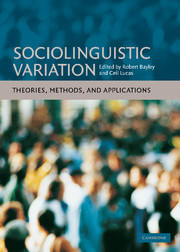Book contents
- Frontmatter
- Contents
- 1 List of figures
- 2 List of tables
- Acknowledgments
- Notes on editors and contributors
- Introduction
- Part 1 THEORIES
- 1 Variation and phonological theory
- 2 Syntactic variation
- 3 The psycholinguistic unity of inherent variability: old Occam whips out his razor
- 4 The study of variation in historical perspective
- 5 Style in dialogue: Bakhtin and sociolinguistic theory
- 6 Variation and historical linguistics
- 7 Second language acquisition: a variationist perspective
- 8 Variation and modality
- Part 2 METHODS
- Part 3 APPLICATIONS
- Afterword: Walt Wolfram and the study of sociolinguistic variation
- References
- Index
8 - Variation and modality
Published online by Cambridge University Press: 16 February 2010
- Frontmatter
- Contents
- 1 List of figures
- 2 List of tables
- Acknowledgments
- Notes on editors and contributors
- Introduction
- Part 1 THEORIES
- 1 Variation and phonological theory
- 2 Syntactic variation
- 3 The psycholinguistic unity of inherent variability: old Occam whips out his razor
- 4 The study of variation in historical perspective
- 5 Style in dialogue: Bakhtin and sociolinguistic theory
- 6 Variation and historical linguistics
- 7 Second language acquisition: a variationist perspective
- 8 Variation and modality
- Part 2 METHODS
- Part 3 APPLICATIONS
- Afterword: Walt Wolfram and the study of sociolinguistic variation
- References
- Index
Summary
Introduction
As can be seen from the other chapters in this volume, spoken languages have been the focus of most studies of sociolinguistic variation, but work has also been done on sociolinguistic variation in sign languages and a basic theoretical question arises: “In what way, if any, is modality reflected in variation?” That is, does sociolinguistic variation in sign languages exactly parallel what has been described for spoken languages or is the fact that sign languages are produced with the hands, face, and body as opposed to with the vocal apparatus borne out in the sociolinguistic variation that sign languages exhibit? Do visual sign languages and oral–aural spoken languages differ in fundamental ways when it comes to sociolinguistic variation? And what of the constraints, both linguistic and social, on this variation? This chapter will review the history of the study of sociolinguistic variation in sign languages, with a focus on American Sign Language (ASL), describe the ways in which sign language variation parallels spoken language variation, and discuss some ways in which modality differences may show up in variation.
Signs have parts
The title heading for this section is also the title of a 1980 chapter by Robbin Battison in which he reviews William C. Stokoe's ideas about the structure of sign languages. For the purposes of the present chapter, it is important for the reader to grasp a basic concept about the structure of the signs in any sign language, namely that signs are not at all indivisible wholes; rather, they have parts analogous to the parts of spoken words.
- Type
- Chapter
- Information
- Sociolinguistic VariationTheories, Methods, and Applications, pp. 145 - 162Publisher: Cambridge University PressPrint publication year: 2007
- 2
- Cited by



